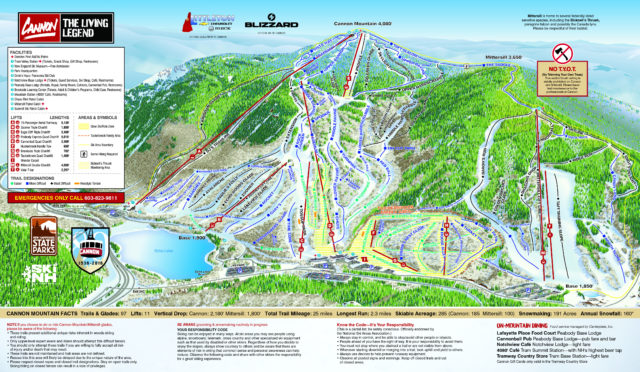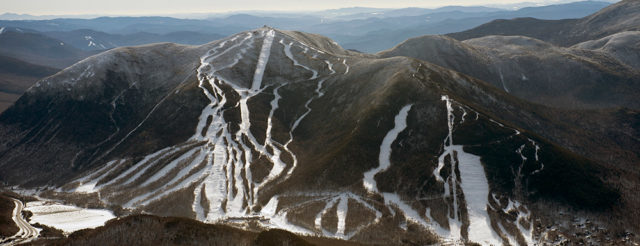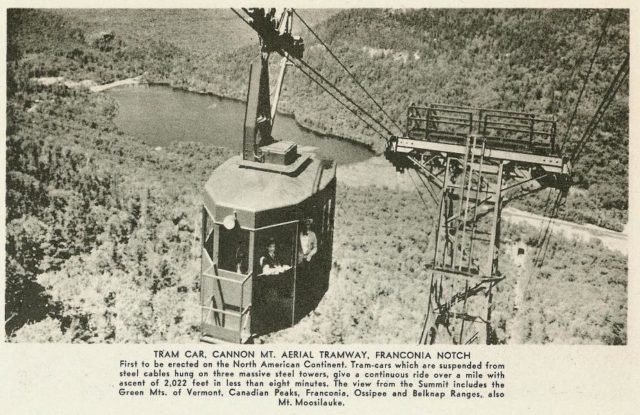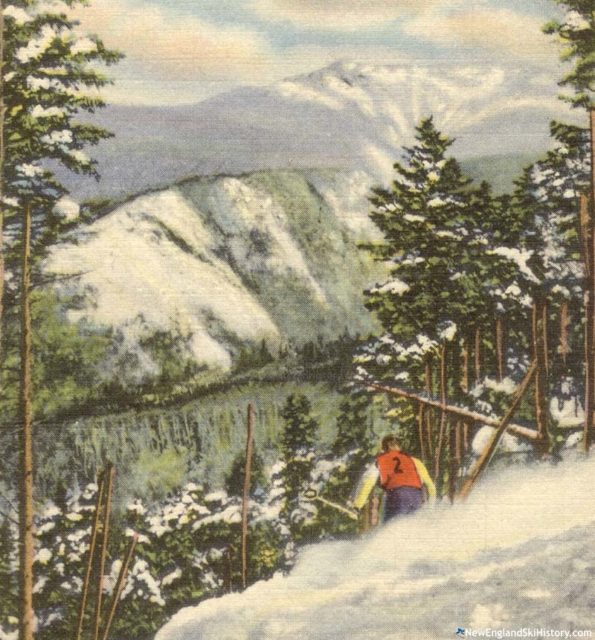By Sarah Sherwood, SCA Franconia Notch State Park Interpretive Ranger and NH Corps Member
Fall is one of my personal favorite times of the year, but it’s not because I am a Halloween fanatic or pumpkin spice devotee. I love fall because it means that my #1 favorite season is right around the corner: ski season. And what better place to prep for winter than Franconia Notch State Park, home of one of the most historically significant ski areas in the US?

Cannon Mountain is a popular destination for parkgoers in all seasons due to its historic Aerial Tramway, but its real primetime begins when the snow starts to fall. One doesn’t have to be a winter sport enthusiast to admire Cannon’s rich history as a leader of commercial and competitive skiing in New England.

Cannon is home to the oldest passenger tramway in North America; it celebrated its monumental 80th year in 2018. The idea for a tram in New Hampshire was first proposed by Alexander Bright, an Olympic skier who observed the success of trams in Europe during the 1933 Olympics. He recognized the potential of the tramway to increase tourism to the White Mountains both during the ski season and the summer months. By November 1933, L.R. Batemen (of the American Steel and Wire Company), E.J. Lloyd, and Roland Peabody of Franconia were conducting the first physical survey of Franconia Notch to determine the feasibility of a passenger tram.

The New Hampshire Legislature enthusiastically backed the endeavor, agreeing that the project would benefit locals and tourists alike. By spring of 1934, a committee headed by Governor John G. Winant unanimously approved the construction of a tram in the White Mountains. Cannon Mountain, a brand-new resort at the time, was chosen as the site due to environmental concerns. The slopes required minimal forest cutting to accommodate the project and the location would not significantly detract from the beautiful scenery of the surrounding park.

Financial concerns swamped the project until 1937, when construction finally began in earnest. Meanwhile, 200 Civilian Conservation Corps men set to work on four new ski trails (to add to the existing Richard Taft Race Course) and a parking lot for the ski hill. Most of the materials for the tramway – including 32 carloads of cement, 232 tons of steel, and four miles of cable – were carried by backpack up the mountain and erected by hand. On June 28, 1938, five years after its conception, the monumental feat of engineering and labor was dedicated.

The tram was an instant success, carrying 163,000 passengers in its first year. During the original tram’s 42-year run from 1938 to 1980, a whopping total of 6,581,338 people rode the car to the mountain’s summit. In 1980 two new, larger tram cars took over for the aging legend. The original tram car can still be seen today at the New England Ski Museum, next door to the Aerial Tramway.

While the Tram is perhaps the best known feature of Cannon Mountain, it is only one of its claims to fame. In 1938 – the same year the Tram debuted – Cannon Mountain hired the first group of paid ski patrollers in the country. As professional patrollers, they were not only in charge of keeping skiers safe, but also for hand-grooming the slopes in the days before machines and tools did the job. It took two full days to prepare one trail for skiing, using only shovels and hard work.

The mountain has trails for all ages and abilities, from beginner to Olympian. In fact, one of the best known Olympic alpine skiers of the 21st century calls Cannon his home. Raised in Franconia, Bode Miller is the most successful male alpine skier of all time with six Olympic medals (one gold, three silver, two bronze), two overall World Cup championships, and 33 individual World Cup race wins. Although he retired from ski racing in 2017, Miller remains a local hero. His Olympic medals can be viewed at the New England Ski Museum for no cost, an experience that every fan of the Games should have.

Today, Cannon remains one of the most challenging and enjoyable ski areas in New England. It tops the New Hampshire charts for vertical at 2,330 feet (7th in New England) and boasts the steepest trail in the east, DJ’s Tramline. The Tramline has been rated as one of the toughest, gnarliest trails in the Northeast; it’s so rocky that it can’t be groomed or covered by snow-making machines. For families and newcomers, lessons are available and even the easier lower mountain runs boast incredible views.

Cannon Mountain’s rich history and wealth of recreational opportunities make it an enviable vacation destination year-round. No need to mourn the short life of this season’s beautiful foliage – winter is coming! I’ll see you on the slopes.

You can learn more about Cannon and buy tickets here: https://www.cannonmt.com/. More information about the New England Ski Museum can be found here: https://newenglandskimuseum.org/. Happy skiing!

(from newenglandskihistory.com)


Best skiing and best ticket prices for those who really love to ski. Also a great staff to make sure you have a great day on the slopes.
Love Cannon’s history and it’s rugged terrain. Been skiing there for 48 years. I have to say lately the quality of snowmaking and grooming has been very poor starting with last season. Also, here are many hazards, both natural and left over from snowmaking that are not marked. Safety does not seem to be a priority at Cannon these days. I hope they correct these shortcomings or they will gradually lose my business and others as well. Jeff.
The things you complain about are the same things that make Cannon what it is. We love skiing the snow making whales. As far as the hazzards you talk about, you should always be paying attention. I love that Cannon gives us the opportunity to ski terrain other places might close. Keep Cannon Cannon.